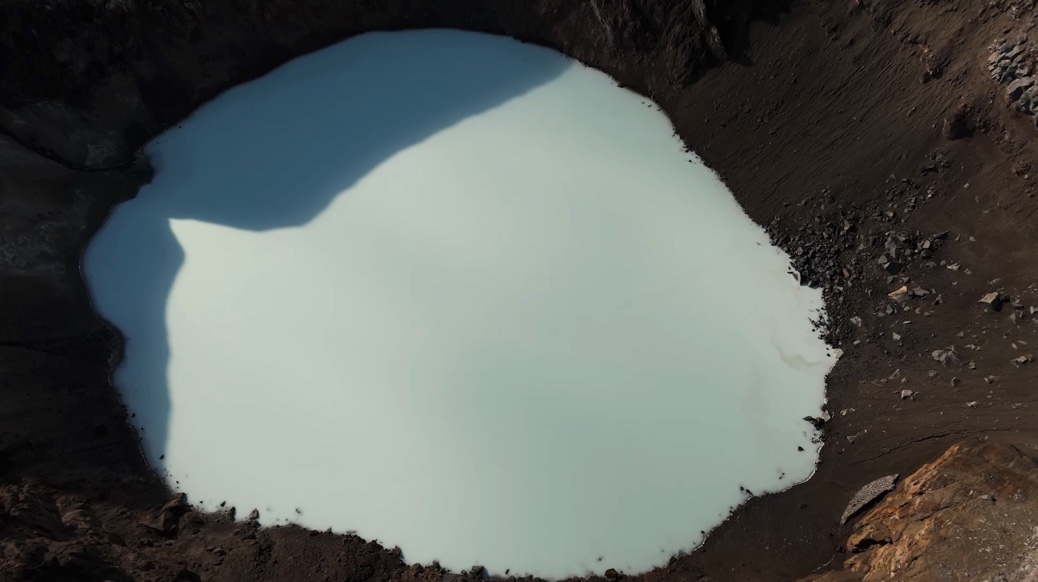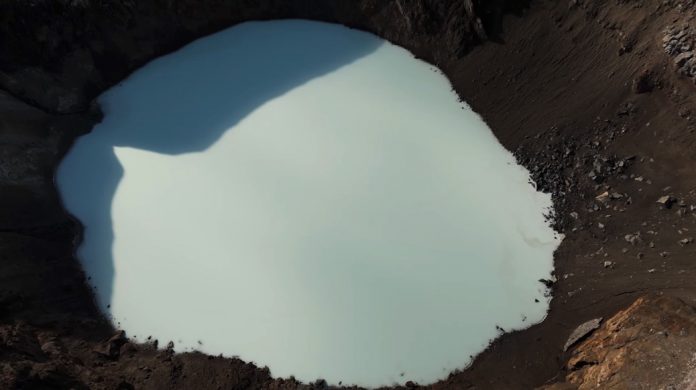ก๊าซซัลเฟอร์พิษพร้อมกลิ่นไข่เน่าลอยฟุ้งออกจากช่องระบายบนผนังปากปล่องภูเขาไฟ Viti ในไอซ์แลนด์ ขณะที่ก๊าซคาร์บอนไดออกไซด์พุ่งขึ้นบนผิวน้ำทะเลสาบสีฟ้าน้ำนม โดยมีไอน้ำปกคลุมภูมิทัศน์ที่เต็มไปด้วยก้อนหินหลวมๆ ในแสงสลัวอย่างน่าขนลุก
ในพื้นที่ซึ่งมีชื่อว่า “Viti” แปลว่า “นรก” ในภาษาไอซ์แลนด์ มิเชล พาร์กส์ นักภูเขาไฟวิทยาจากสำนักงานอุตุนิยมวิทยาไอซ์แลนด์ ได้เดินทางไปที่ขอบน้ำทะเลสาบเมื่อเดือนสิงหาคมที่ผ่านมา พร้อมเครื่องเตือนภัยที่คาดอยู่เพื่อเตือนหากก๊าซพิษมีระดับสูงเกินไป เธอหย่อนเครื่องวัดอุณหภูมิลงในทะเลสาบ พบว่าอุณหภูมิอยู่ที่ 26.4 องศาเซลเซียส (79.5 องศาฟาเรนไฮต์) ซึ่งยังคงสอดคล้องกับค่าที่วัดได้ก่อนหน้า ถือเป็นสัญญาณที่น่าพอใจในขณะนั้น
ปล่องภูเขาไฟแห่งนี้เกิดขึ้นจากการปะทุครั้งใหญ่ของภูเขาไฟ Askja ในอุทยานแห่งชาติ Vatnajökull ทางตอนกลางของไอซ์แลนด์ เมื่อปี ค.ศ. 1875 โดยครั้งล่าสุดที่ภูเขาไฟนี้ปะทุในปี ค.ศ. 1961 นั้นมีความรุนแรงน้อยกว่า และเงียบสงบมานานหลายสิบปี กระทั่งปี ค.ศ. 2021 พาร์กส์และนักวิทยาศาสตร์หลายคนพบว่าภูเขาไฟนี้ขยายตัวเร็วขึ้นอย่างไม่คาดคิดในช่วงไม่กี่เดือน พื้นดินยกตัวขึ้นถึง 11 เซนติเมตร (4.3 นิ้ว) ปรากฏการณ์นี้เรียกว่า “การพองตัว” เกิดจากมวลแมกมาหรือก๊าซที่สะสมใต้ภูเขาไฟ ดันพื้นผิวขึ้นสู่ด้านบน
นับจากนั้นในช่วงสามปีที่ผ่านมา การพองตัวของ Askja ขยายเพิ่มขึ้นถึงประมาณ 80 เซนติเมตร โดยนักวิทยาศาสตร์ประมาณว่าปริมาณแมกมามากถึง 44 ล้านลูกบาศก์เมตร กำลังไหลเข้าสู่แหล่งสะสมใต้พื้นดินลึกประมาณสามกิโลเมตรจากผิวดิน
นักภูเขาไฟวิทยาพบความสัมพันธ์ระหว่างการสะสมของแมกมากับการปะทุ แต่ยังไม่แน่ชัดว่าแมกมาต้องสะสมมากแค่ไหนจึงจะทำให้ภูเขาไฟระเบิดได้ นี่เป็นเหตุผลที่พาร์กส์และทีมงานตรวจสอบอุณหภูมิและความเป็นกรดของทะเลสาบ Viti อย่างใกล้ชิด หากมีการเพิ่มขึ้นของค่าทั้งสองนี้ อาจบ่งชี้ถึงก๊าซที่ไหลขึ้นมาจากใต้พื้นดินซึ่งอาจจะเป็นสัญญาณว่าภูเขาไฟใกล้จะปะทุ จนถึงขณะนี้ยังไม่พบการเปลี่ยนแปลงที่ผิดปกติ แต่ทีมวิทยาศาสตร์ยังคงติดตามอย่างระมัดระวัง
“มีความไม่แน่นอนมากมายว่าเมื่อไหร่จะปะทุ หรือหากจะปะทุจริงๆ” พาร์กส์กล่าว “มันอาจจะเกิดขึ้นในอีกหลายปีหรือหลายทศวรรษ หรืออาจจะเร็วกว่านั้น”
Is climate change lighting a fuse under Iceland’s volcanoes?

Toxic sulphurous gas, carrying the telltale reek of rotten eggs, wafted through vents in the steep walls of Iceland’s Viti crater, while carbon dioxide bubbled to the surface of the milky blue crater lake. Veils of steam wreathed the landscape of loose rock in eerie half-light.
Through this forbidding terrain – “Viti” is derived from the Icelandic for “hell” – Michelle Parks, a volcanologist with the Icelandic Meteorological Office, picked her way toward the water’s edge one day last August. With a monitor strapped to her hip to warn her if the gases reached dangerous levels, she stooped to submerge a temperature probe in the lake – 26.4 degrees Celsius (79.5 degrees Fahrenheit), consistent with recent readings.
That was reassuring, at least for the time being. The crater was formed when Askja, a volcano in Vatnajokull National Park in Iceland’s central highlands, uncorked in an explosive eruption in 1875. Askja’s last eruption, in 1961, was milder, and for decades after, the volcano was quiet. But in 2021, Parks and other scientists keeping tabs on it were shocked to find that in just a few months, the volcano had rapidly expanded, uplifting by 11 centimetres (4.3 inches). This phenomenon, called inflation, occurs when magma or pressurised gases accumulate under a volcano, pushing the ground upwards and outwards.
In the three years since, Askja’s bloat has reached about 80 cm (32 inches). That uplift, scientists estimate, is the result of 44 million cubic metres (1.6 billion cubic feet) of magma flowing into the existing reservoir around three km (two miles) beneath the surface.
Volcanologists have established a correlation between magma buildup under a volcano and subsequent eruption. But they don’t know exactly how much magma is needed to help trip an eruption. That is why Parks and her colleagues are closely monitoring the temperature and acidity of Viti’s crater lake. A jump in either, indicating that more gases are pushing in from below, would suggest the volcano is moving closer to an eruption. So far, those metrics have remained stable, but the scientists watching Askja don’t take that for granted.
“There’s so much uncertainty on when this will erupt — if it will erupt,” Parks said. It could be years, or decades, she said, or “it could be sooner.”
By Gloria Dickie, Reauters
Photography By Stoyan Nenov
Graphics By Sam Hart And Anurag Rao
Video By Kuba Stężycki

















